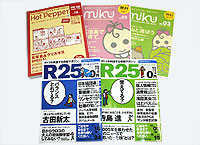|
|
|||||||
|
|
|||||||
|
|||||||
| | Web Japan >> | Trends in Japan >> | Business & Economy >> | Something For Nothing | |
|
SOMETHING FOR NOTHING The Rise and Rise of Free Publications (December 27, 2005) Free newspapers and magazines have rapidly evolved into one of the most exciting subsectors of the publishing industry, with the annual circulation of free publications currently standing at more than 200 million. With many free publications targeted at specific groups, they are being eyed by businesses as a new advertising medium. In a bid to attract more readers, an increasing number of these papers and magazines are carrying articles of a surprisingly high quality - defying the old maxim that "you get what you pay for." Their rising standards have made them into a formidable rival to paid publications. Rising Circulation In the revised 2003 edition of Zenkoku Furi Pepa Gaido (Nationwide Guide to Free Papers), the Japan Free Newspapers Association states that 1,156 free newspapers and magazines were published in 2003, and their combined circulation exceeded 220 million. What accounts for the rapid growth of this market? Until now, income from sales and advertising constituted the main revenue sources for publishing firms. But with people reading less and using the Internet more as a source of free information, income from sales of paid newspapers, magazines, and books has been on the decline. This very environment, however, has proved ideal for free newspapers and magazines. As sales income is not part of their business plans, they can focus on maximizing advertising revenue by distributing their publications to as many readers as possible. High Quality Reading Matter A more recent entrant to the free-publication scene is Miku, a magazine targeted at women with children under the age of three, which was launched in March 2005. The publisher, Zenkyoshin Co., says that the aim of Miku is to help halt the decline in the birthrate by offering articles that provide support for new mothers and make parenting more enjoyable. Distribution is the key to success for free publications. Many publishers place stands in stations, on street corners, and in other high-profile locations, though there are a variety of other arrangements. Community papers, for example, are generally delivered to individual households in a certain area, while restaurant guides with discount coupons are often made available at the eating establishments featured in their pages. Though paid publications generally go through distribution agents, free papers are not bound by such conventions, and publishers can distribute the papers themselves or find other routes to get information directly to readers and consumers. The market for free papers is likely to continue expanding, shaped by a constant stream of innovations. Copyright (c) 2005 Web Japan. Edited by Japan Echo Inc. based on domestic Japanese news sources. Articles presented here are offered for reference purposes and do not necessarily represent the policy or views of the Japanese Government. |
||
|



